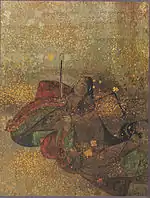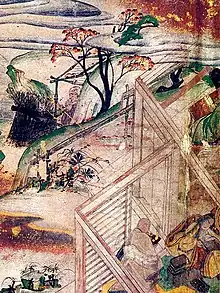Heike Nokyo
The Heike Nōkyō 平家納経, is a collection of Buddhist religious texts in Japan from the late Heian period. These texts include 33 scrolls of the Lotus Sutra, one Amitabha Sutra scroll, one Heart Sutra scroll and one prayer scroll dedicated to the Itsukushima Shrine.[1] The Nōkyō is written in a form of Japanese known in English as Classical Japanese.

It has had a profound influence on Japanese culture and Japanese art and was created during a golden age of Japanese art history. It is one of the masterpieces of decorated sutras ( sôshoku kyô ) of the Heian period Emakimono texts and is considered a National Treasure of Japan.[2]
History and development
The Nōkyō was commissioned by the Taira clan and dedicated by Taira no Kiyomori (1118-81CE) to Itsukushima Shrine in 1164CE in a prayer scroll (Heike Nogyo).[3] It was made by aristocratic circles in the 12th century and depicts the tale of the Heike, numbering 33 to represent the 33 goddesses found at Itsukushima who were said to take the form of Kannon.[4][5] The Nokyo was written in Classical Japanese, Classical Chinese and the Kana script formatted as Ashida-E (reed writing) representing a votive and religious work of Heian-specific Art.[6]
In 1602, the Rinpa painter Tawaraya Sotatsu was commissioned to restore the Nokyo which affected his painting.[7]
Gallery
 Lotus Sutra Prologue
Lotus Sutra Prologue Chapter 12 Lotus Sutra
Chapter 12 Lotus Sutra Woman from Chapter 12
Woman from Chapter 12
See also
References
- Rites and Rule: Kiyomori at Itsukushima and Fukuhara, Heather Blair, June 2013, Vol. 73, No. 1, p.22
- The term "National Treasure" has been used in Japan to denote cultural properties since 1897. Architecture and authority in Japan, William Howard Coaldrake, 1996[2002], p.248, ISBN 0-415-05754-X, Routledge| See
- The Buddhist Mythmaking of Defilement: Sacred Courtesans in Medieval Japan, Michele Marra, The Journal of Asian Studies, February 1993, Vol. 52, No. 1, p.55
- Rites and Rule: Kiyomori at Itsukushima and Fukuhara, Heather Blair, June 2013, Vol. 73, No. 1, p.22
- Disguised Scripts and Hidden Poems in an Illustrated Heian Sutra: Ashide and Uta-E in the Heike Nōgyō, Julia Meech-Pekarik, Archives of Asian Art , 1977/1978, Vol. 31, p. 53
- Disguised Scripts and Hidden Poems in an Illustrated Heian Sutra: Ashide and Uta-E in the Heike Nōgyō, Julia Meech-Pekarik, Archives of Asian Art , 1977/1978, Vol. 31, p. 53
- Encyclopedia of world biography. Vol. 17, Paula K Byers, 1998, Index, ISBN 0787622214, London, Gale